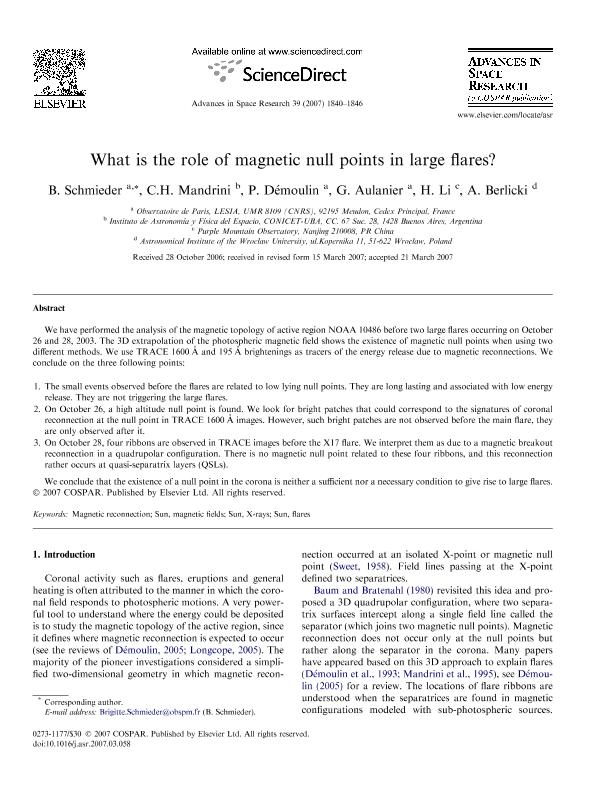Mostrar el registro sencillo del ítem
dc.contributor.author
Schmieder, B.
dc.contributor.author
Mandrini, Cristina Hemilse

dc.contributor.author
Démoulin, Pascal

dc.contributor.author
Aulanier, G.
dc.contributor.author
Li, H.
dc.contributor.author
Berlicki, A.
dc.date.available
2017-07-21T13:50:46Z
dc.date.issued
2007-12
dc.identifier.citation
Schmieder, B.; Mandrini, Cristina Hemilse; Démoulin, Pascal; Aulanier, G.; Li, H.; et al.; What is the role of magnetic null points in large flares?; Elsevier; Advances in Space Research; 39; 12; 12-2007; 1840-1846
dc.identifier.issn
0273-1177
dc.identifier.uri
http://hdl.handle.net/11336/21055
dc.description.abstract
We have performed the analysis of the magnetic topology of active region NOAA 10486 before two large flares occurring on October 26 and 28, 2003. The 3D extrapolation of the photospheric magnetic field shows the existence of magnetic null points when using two different methods. We use TRACE 1600 Å and 195 Å brightenings as tracers of the energy release due to magnetic reconnections. We conclude on the three following points:
1.
The small events observed before the flares are related to low lying null points. They are long lasting and associated with low energy release. They are not triggering the large flares.
2.
On October 26, a high altitude null point is found. We look for bright patches that could correspond to the signatures of coronal reconnection at the null point in TRACE 1600 Å images. However, such bright patches are not observed before the main flare, they are only observed after it.
3.
On October 28, four ribbons are observed in TRACE images before the X17 flare. We interpret them as due to a magnetic breakout reconnection in a quadrupolar configuration. There is no magnetic null point related to these four ribbons, and this reconnection rather occurs at quasi-separatrix layers (QSLs).
We conclude that the existence of a null point in the corona is neither a sufficient nor a necessary condition to give rise to large flares.
dc.format
application/pdf
dc.language.iso
eng
dc.publisher
Elsevier

dc.rights
info:eu-repo/semantics/openAccess
dc.rights.uri
https://creativecommons.org/licenses/by-nc-sa/2.5/ar/
dc.subject.classification
Astronomía

dc.subject.classification
Ciencias Físicas

dc.subject.classification
CIENCIAS NATURALES Y EXACTAS

dc.title
What is the role of magnetic null points in large flares?
dc.type
info:eu-repo/semantics/article
dc.type
info:ar-repo/semantics/artículo
dc.type
info:eu-repo/semantics/publishedVersion
dc.date.updated
2017-07-18T17:16:38Z
dc.journal.volume
39
dc.journal.number
12
dc.journal.pagination
1840-1846
dc.journal.pais
Países Bajos

dc.journal.ciudad
Amsterdam
dc.description.fil
Fil: Schmieder, B.. Centre National de la Recherche Scientifique. Observatoire de Paris; Francia
dc.description.fil
Fil: Mandrini, Cristina Hemilse. Consejo Nacional de Investigaciónes Científicas y Técnicas. Oficina de Coordinación Administrativa Ciudad Universitaria. Instituto de Astronomía y Física del Espacio. - Universidad de Buenos Aires. Facultad de Ciencias Exactas y Naturales. Instituto de Astronomía y Física del Espacio; Argentina
dc.description.fil
Fil: Démoulin, Pascal. Centre National de la Recherche Scientifique. Observatoire de Paris; Francia
dc.description.fil
Fil: Aulanier, G.. Centre National de la Recherche Scientifique. Observatoire de Paris; Francia
dc.description.fil
Fil: Li, H.. Purple Mountain Observatory; China
dc.description.fil
Fil: Berlicki, A.. Astronomical Institute of the Wrocław University; Polonia
dc.journal.title
Advances in Space Research

dc.relation.alternativeid
info:eu-repo/semantics/altIdentifier/doi/http://dx.doi.org/10.1016/j.asr.2007.03.058
dc.relation.alternativeid
info:eu-repo/semantics/altIdentifier/url/http://www.sciencedirect.com/science/article/pii/S0273117707002943
Archivos asociados
